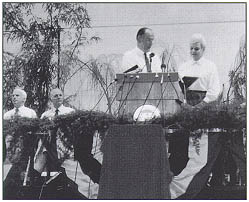August 10
| 1956 | PPM 20-8 implements Section 116(c) of the Federal-Aid Highway Act of 1956, which requires that in deciding whether to bypass any city, town, or village, the State highway department must hold public hearings or afford the opportunity for such hearings, and consider the economic effects of the action. | |
| 1970 | After the National Highway Safety Bureau was separated from FHWA to become the seventh USDOT operating administration in March 1970, FHWA was reorganized, effective this date. Under the change, BPR is eliminated as an identifiable separate organizational component. Instead of a bureau structure, FHWA is divided into six components, each headed by an Associate Administrator (Administration, Planning, Engineering and Traffic Operations, Motor Carrier and Highway Safety, Research and Development, and Right-of-Way and Environment). The Offices of Chief Counsel, Civil Rights, Program Review and Investigations, and Public Affairs, each headed by a Director, report directly to the Administrator. | |
| 1989 | Attorney General Dick Thornburgh administers the oath of office to Dr. Thomas D. Larson as the 12th Federal Highway Administrator. He calls the post-Interstate period "a hinge point in this country's transportation history."
"Under Secretary Skinner's empowering leadership, this team will give our country the direction it needs in transportation to grow confidently, prosperously and securely towards the 21st century." | |
| 1990 | Opening of the Papago Freeway in Phoenix, AZ, completes the 2,460-mile I-10, the second transcontinental Interstate route to be completed (Jacksonville, FL, to Santa Monica, CA). The Director of the Office of Engineering in Headquarters, Thomas O. Willett, who was Division Administrator in Arizona while controversy surrounding the route was resolved, is quoted as saying, "Completion of the Papago Freeway is far more than construction of concrete and steel. It represents a successful culmination of a state, city, and federal partnership forged by the challenge of a concerned public."
| |
| 2005 | In a ceremony in the Caterpillar-Aurora Facility in Peoria, Illinois, President George W. Bush signs the Safe, Accountable, Flexible, Efficient Transportation Equity Act: A Legacy for Users (SAFETEA-LU). The Act reauthorizes Federal-aid highway, transit, and safety programs through FY 2009. The President says, "this is more than just a highway bill; it's a safety bill." SAFETEA-LU "makes our highways and mass transit systems safer and better, and it will help more people find work. And it accomplishes [these] goals in a fiscally responsible way." |

